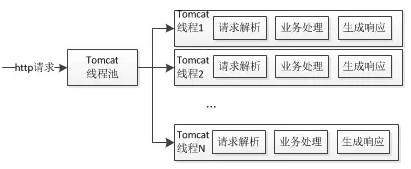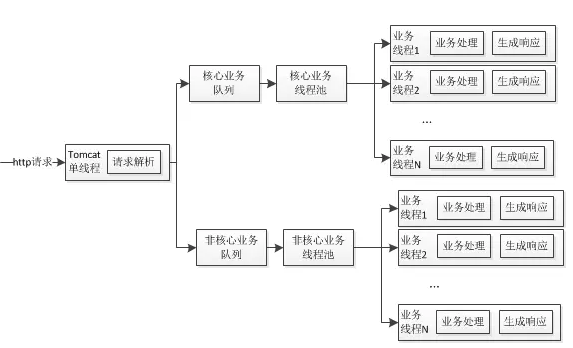线程隔离主要是针对业务中不同业务场景,按照权重区分使用不同的线程池,以达到某一个业务出现问题,不会将故障扩散到其他的业务线程池,从而达到保证主要业务高可用。
首先我们回忆一下在tomcat6,tomcat6只支持BIO,它的处理流程如下:
1).tomcat负责接收servletRequest请求
2).将接收的请求分配给servlet处理业务
3).处理完请求之后,通过servletResponse写会数据
上面这三步都是在一个线程里面完成的,也就是同步进行。
如下图:

tomcat7之后版本引入了servlet3,它基于NIO能处理更大的并发数。
我们可以将整个请求改造成如下步骤:
1).tomcat单线程进行请求解析
2).解析完之后将task放入队列(可以根据不同业务类型放入不同的队列)
3).每个队列指定相应业务线程池对task进行处理
这样改造以后就可以把业务按照重要性发送到不同线程池,两个线程池分开独立配置,互不干扰。当非核心的业务出现问题之后,不会影响核心的业务。另外由于此线程池是有我们创建的,我们可以对该线程池进行监控,处理,灵活了很多。
如下图:

下面是实现代码:
接口层调用
@RestController
@RequestMapping("/app")
public class NIOCtrl {
@Autowired
private LocalNewsAsyncContext localNewsAsyncContext;
@Autowired
private NewsService newsService;
@RequestMapping("/news")
public void getNews(HttpServletRequest request,@RequestParam(value = "type",required = false) String type){
if("1".equals(type)){
localNewsAsyncContext.submit(request, () -> newsService.getNews());
return;
}
localNewsAsyncContext.submit(request, () -> newsService.getNewsMap());
}
}
将请求丢进指定线程池
@Service
public class LocalNewsAsyncContext {
private final static Long timeOutSeconds= 5L;
@Autowired
private CustomAsyncListener asyncListener;
@Autowired
private ThreadPoolExecutor executor;
public void submit(final HttpServletRequest request,final Callable<Object> task){
final String uri= request.getRequestURI();
final Map<String,String[]> params= request.getParameterMap();
//开启异步上下文
final AsyncContext asyncContext= request.startAsync();
asyncContext.getRequest().setAttribute(Constant.URI,uri);
asyncContext.getRequest().setAttribute(Constant.PARAMS, params);
asyncContext.setTimeout(timeOutSeconds * 1000);
if(asyncContext!=null){
asyncContext.addListener(asyncListener);
}
executor.submit(new CustomCallable(asyncContext, task));
}
}
自定义线程处理
public class CustomCallable implements Callable{
private static final Logger LOG = LoggerFactory.getLogger(CustomCallable.class);
public AsyncContext asyncContext;
private Callable<Object> task;
private String uri;
private Map<String,String[]> params;
public CustomCallable(AsyncContext asyncContext, Callable<Object> task){
this.asyncContext= asyncContext;
this.task= task;
this.uri= (String) asyncContext.getRequest().getAttribute(Constant.URI);
this.params= (Map<String, String[]>) asyncContext.getRequest().getAttribute(Constant.PARAMS);
}
@Override public Object call() throws Exception {
Object o= task.call();
if(o==null){
callback(asyncContext,o);
}else if(o instanceof String){
callback(asyncContext, o);
}else if(o instanceof CompletableFuture){
CompletableFuture<Object> future= (CompletableFuture<Object>) o;
future.thenAccept(o1 -> callback(asyncContext, o1))
.exceptionally(throwable -> {
callback(asyncContext,"");
return null;
});
}else {
callback(asyncContext, o);
}
return null;
}
private void callback(AsyncContext asyncContext,Object result){
HttpServletResponse response= (HttpServletResponse) asyncContext.getResponse();
try{
if(result instanceof String){
write(response, (String) result);
}else {
write(response, JSON.toJSONString(result));
}
}catch (Exception e){
response.setStatus(HttpServletResponse.SC_INTERNAL_SERVER_ERROR);
e.printStackTrace();
try {
LOG.error("get info error for uri:{}, params:{}",uri,JSON.toJSONString(params),e);
}catch (Exception e1){}
}finally {
asyncContext.complete();
}
}
private void write(HttpServletResponse response,String result) throws IOException {
response.getOutputStream().write(result.getBytes());
}
}
定义业务线程池
@Configuration
public class LocalNewsPoolConfig {
private final static Logger LOG= LoggerFactory.getLogger(LocalNewsPoolConfig.class);
@Bean
public ThreadPoolExecutor init(){
int corePoolSize= 10;
int maximumPoolSize= 100;
int queueCapacity= 200;
LinkedBlockingDeque<Runnable> queue= new LinkedBlockingDeque<>(queueCapacity);
ThreadPoolExecutor executor= new ThreadPoolExecutor(corePoolSize,maximumPoolSize,60L, TimeUnit.SECONDS,queue);
executor.allowCoreThreadTimeOut(true);
executor.setRejectedExecutionHandler((r, executor1) -> {
if(r instanceof CustomCallable){
CustomCallable call= (CustomCallable) r;
AsyncContext asyncContext= call.asyncContext;
if(asyncContext!=null){
handler(asyncContext);
}
}
});
return executor;
}
private static void handler(AsyncContext asyncContext){
try{
ServletRequest req= asyncContext.getRequest();
String uri= (String) req.getAttribute(Constant.URI);
Map params= (Map) req.getAttribute(Constant.PARAMS);
LOG.error("async req rejected. uri :{},params:{}",uri, JSON.toJSONString(params));
}catch (Exception e){
e.printStackTrace();
try{
HttpServletResponse response= (HttpServletResponse) asyncContext.getResponse();
response.setStatus(HttpServletResponse.SC_INTERNAL_SERVER_ERROR);
}catch (Exception e1){}
}finally {
asyncContext.complete();
}
}
}
定义异步请求监听
@Component
public class CustomAsyncListener implements AsyncListener {
private Logger LOG= LoggerFactory.getLogger(CustomAsyncListener.class);
@Override public void onComplete(AsyncEvent asyncEvent) throws IOException {
}
@Override public void onTimeout(AsyncEvent asyncEvent) throws IOException {
AsyncContext asyncContext= asyncEvent.getAsyncContext();
try{
ServletRequest req= asyncContext.getRequest();
String uri= (String) req.getAttribute(Constant.URI);
Map params= (Map) req.getAttribute(Constant.PARAMS);
LOG.error("async req timeOut. uri :{},params:{}",uri, JSON.toJSONString(params));
}catch (Exception e){
e.printStackTrace();
}finally {
try{
HttpServletResponse response= (HttpServletResponse) asyncContext.getResponse();
response.setStatus(HttpServletResponse.SC_REQUEST_TIMEOUT);
}catch (Exception e1){}
asyncContext.complete();
}
}
@Override public void onError(AsyncEvent asyncEvent) throws IOException {
AsyncContext asyncContext= asyncEvent.getAsyncContext();
try{
ServletRequest req= asyncContext.getRequest();
String uri= (String) req.getAttribute(Constant.URI);
Map params= (Map) req.getAttribute(Constant.PARAMS);
LOG.error("async req error. uri :{},params:{}",uri, JSON.toJSONString(params));
}catch (Exception e){
e.printStackTrace();
try{
HttpServletResponse response= (HttpServletResponse) asyncContext.getResponse();
response.setStatus(HttpServletResponse.SC_INTERNAL_SERVER_ERROR);
}catch (Exception e1){}
}finally {
asyncContext.complete();
}
}
@Override public void onStartAsync(AsyncEvent asyncEvent) throws IOException {
}
}
业务处理和常量类
@Service
public class NewsService {
public String getNews(){
return "servlet3 nio test.";
}
public StringBuilder getNewsMap(){
return new StringBuilder("I do and i understand.");
}
}
public class Constant {
public static final String URI= "uri";
public static final String PARAMS= "params";
}
来源:https://www.jianshu.com/p/0529c126e166?utm_campaign


